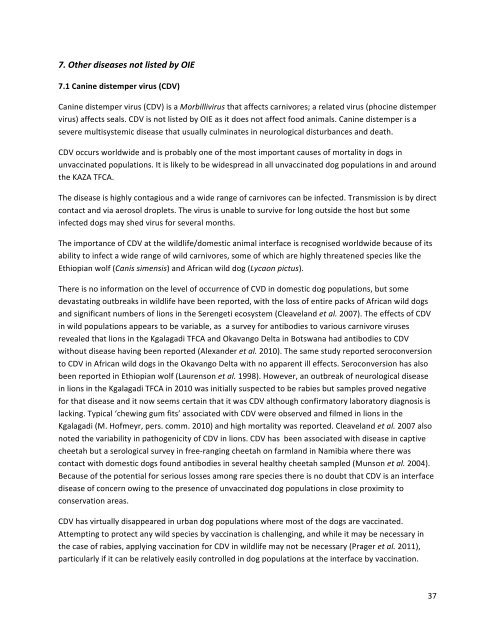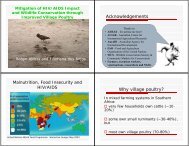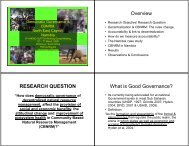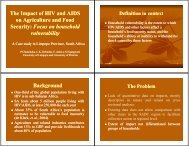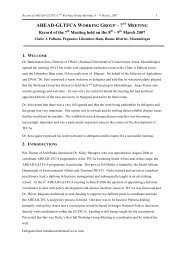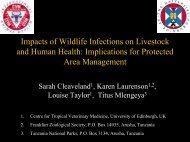Download - Animal & Human Health for the Environment and ...
Download - Animal & Human Health for the Environment and ...
Download - Animal & Human Health for the Environment and ...
You also want an ePaper? Increase the reach of your titles
YUMPU automatically turns print PDFs into web optimized ePapers that Google loves.
7. O<strong>the</strong>r diseases not listed by OIE 7.1 Canine distemper virus (CDV) Canine distemper virus (CDV) is a Morbillivirus that affects carnivores; a related virus (phocine distemper virus) affects seals. CDV is not listed by OIE as it does not affect food animals. Canine distemper is a severe multisystemic disease that usually culminates in neurological disturbances <strong>and</strong> death. CDV occurs worldwide <strong>and</strong> is probably one of <strong>the</strong> most important causes of mortality in dogs in unvaccinated populations. It is likely to be widespread in all unvaccinated dog populations in <strong>and</strong> around <strong>the</strong> KAZA TFCA. The disease is highly contagious <strong>and</strong> a wide range of carnivores can be infected. Transmission is by direct contact <strong>and</strong> via aerosol droplets. The virus is unable to survive <strong>for</strong> long outside <strong>the</strong> host but some infected dogs may shed virus <strong>for</strong> several months. The importance of CDV at <strong>the</strong> wildlife/domestic animal interface is recognised worldwide because of its ability to infect a wide range of wild carnivores, some of which are highly threatened species like <strong>the</strong> Ethiopian wolf (Canis simensis) <strong>and</strong> African wild dog (Lycaon pictus). There is no in<strong>for</strong>mation on <strong>the</strong> level of occurrence of CVD in domestic dog populations, but some devastating outbreaks in wildlife have been reported, with <strong>the</strong> loss of entire packs of African wild dogs <strong>and</strong> significant numbers of lions in <strong>the</strong> Serengeti ecosystem (Cleavel<strong>and</strong> et al. 2007). The effects of CDV in wild populations appears to be variable, as a survey <strong>for</strong> antibodies to various carnivore viruses revealed that lions in <strong>the</strong> Kgalagadi TFCA <strong>and</strong> Okavango Delta in Botswana had antibodies to CDV without disease having been reported (Alex<strong>and</strong>er et al. 2010). The same study reported seroconversion to CDV in African wild dogs in <strong>the</strong> Okavango Delta with no apparent ill effects. Seroconversion has also been reported in Ethiopian wolf (Laurenson et al. 1998). However, an outbreak of neurological disease in lions in <strong>the</strong> Kgalagadi TFCA in 2010 was initially suspected to be rabies but samples proved negative <strong>for</strong> that disease <strong>and</strong> it now seems certain that it was CDV although confirmatory laboratory diagnosis is lacking. Typical ‘chewing gum fits’ associated with CDV were observed <strong>and</strong> filmed in lions in <strong>the</strong> Kgalagadi (M. Hofmeyr, pers. comm. 2010) <strong>and</strong> high mortality was reported. Cleavel<strong>and</strong> et al. 2007 also noted <strong>the</strong> variability in pathogenicity of CDV in lions. CDV has been associated with disease in captive cheetah but a serological survey in free-‐ranging cheetah on farml<strong>and</strong> in Namibia where <strong>the</strong>re was contact with domestic dogs found antibodies in several healthy cheetah sampled (Munson et al. 2004). Because of <strong>the</strong> potential <strong>for</strong> serious losses among rare species <strong>the</strong>re is no doubt that CDV is an interface disease of concern owing to <strong>the</strong> presence of unvaccinated dog populations in close proximity to conservation areas. CDV has virtually disappeared in urban dog populations where most of <strong>the</strong> dogs are vaccinated. Attempting to protect any wild species by vaccination is challenging, <strong>and</strong> while it may be necessary in <strong>the</strong> case of rabies, applying vaccination <strong>for</strong> CDV in wildlife may not be necessary (Prager et al. 2011), particularly if it can be relatively easily controlled in dog populations at <strong>the</strong> interface by vaccination. 37


